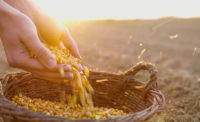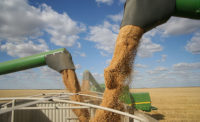Business Strategies | 2019 Crop Report
2019 Crop Report: Riding the crazy train

No two years in farming are alike or free of drama; however, this may be one of the craziest years we’ve seen in a long time because of all the variables in play. My perspective is different than when I was in the protein business. I now head a farming cooperative that specializes in fruits and vegetables, but we interact regularly with cooperatives that primarily support corn and soybeans. I was recently in central Illinois at a time when the corn crop should be shoulders high, yet the corn was only inches high, and there appeared to be unplanted acres compared with a year ago.
What we know for sure is this year’s planting is way behind typical years.
Here are some other facts we know:
- This year, less than an estimated 80 percent of the crop was planted nationally by June 5. Those in this area of specialty have alluded to the fact that this is the latest a crop has been planted in more than 30 years.
- Crop insurance terminated on June 5 because all the statistics say that’s a high risk. Among the risk factors, corn not planted by June 5 has a 50 percent probability of not being properly pollinated. I sat next to a University of Illinois professor at a recent conference, and we discussed all the issues this may cause. According to what I have ascertained, if everything doesn’t go just right, we’re going to have a major shortfall this year in the U.S. crop.
Key risk factors in a late crop planting are:
- Getting the crop harvested before the first freeze.
- Pollination and tasseling is a major issue.
- Corn self-pollinates, but if the temperature is 95 or above when the pollination occurs, it will not be properly spread.
- Additionally, bees do not function and pollinate in high temperatures.
- High temperatures late in the summer make moisture less available to the plant, reducing performance.
- Some Corn Belt area temperatures are below normal and other areas are experiencing high temperatures, which could result in uneven yields in different geographies.
- From a supply standpoint, we still have a very large carryover from traditional years and 2018 was very heavy as well. The farmers who have hung on to this will receive a premium as prices go up. Carryover from 2018 will moderate the price increases to some extent, even if yield is significantly lower.
Stocks
According to the recent U.S. Department of Agriculture (USDA) reports:
- Corn stocks were down 2 percent versus 2018 as of June 28.
- Corn stocks in all positions on June 1 totaled 5.20 billion bushels.
- Soybean stocks were up 47 percent versus 2018 as of June 28.
- Soybeans stored in all positions on June 1 totaled 1.79 billion bushels.
- Wheat stocks are also down 2 percent as of June 28.
Planting
The June 28 report from the USDA also indicated:
- Corn planted in all areas of the U.S. was estimated at 91.7 million acres, up 3 percent compared with last year. Planted acres are unchanged in 40 of the 48 estimated states and areas harvested for grain at 93.6 million is up 2 percent.
- Soybeans planted in 2019 is estimated at 80 million acres, down 10 percent from last year. This represents the lowest number of soybeans planted acres in the United States since 2013. Compared with last year, planted acres are estimated to be down in all 29 estimating states.
- All wheat areas for 2019 are estimated at 45.6 million acres, down 5 percent versus 2018. This represents the lowest wheat planting on record since 1919.
It is important to remember when reviewing the planting numbers that while the total corn acres is technically up a few percentage points over the previous year, the delay in planting and the issues this will raise are not indicated and will likely drop the overall production.
Usually corn, soybeans, wheat and oil prices travel in the same price range. This year will be different. Corn is king when feeding animals throughout the world because it makes the most efficient primary feed ingredient for animals. In Europe, they feed primarily wheat, and in years in which corn was in short supply, U.S. producers used wheat as their primary feed ingredient. Wheat’s feed conversion is approximately 80 percent as effective as a corn/soybean diet.
Globally speaking, it’s important to monitor soybeans, corn and wheat in Brazil, Argentina, Canada, China, Russia, Australia and other countries. Clearly, the trade war with China has restricted feed ingredient trade where soybean and its byproduct are significant. This has limited demand for last year’s crop of soybeans and this fact is the primary driver of the soybean surplus. Both sides understand the long-term global implications of the pending agreement. The Chinese government sees this agreement as a critical step in the nation achieving long-term world dominance in trade, which is critical to support its vast population. The U.S. and global economy are booming, but there is some fear that it’s building to a bubble. If the trade war gets settled, this will be a game-changer for these two groups to improve their situation.
My theory is President Donald J. Trump is using the outbreak of African swine flu as leverage to achieve the best trade agreement possible and he is building some future benchmarks into a final agreement so non-compliance will be punitive. The serious outbreak of African swine flu in Asia will get worse, and it will reduce animal feeding causing a reduced demand for feed ingredients. It will also result in a significant export demand for both pork and chicken to the Chinese population. Clearly, chicken will be substituted for pork even though it’s not today’s preferred protein in many Asian nations.
Looking to the future, plant genetics continue to improve the yield that we can expect from corn, soybeans and wheat. With the large swine population in China, Vietnam, North Korea and other countries in peril, this will affect the feed ingredients consumed by the animals that will perish.
Hopefully, many of you hedged when the market was in the tank and you have a good percentage of your requirements settled at a very low price.
With all these factors and the unpredictability of Mother Nature, we are in for a volatile summer. NP
Looking for a reprint of this article?
From high-res PDFs to custom plaques, order your copy today!







